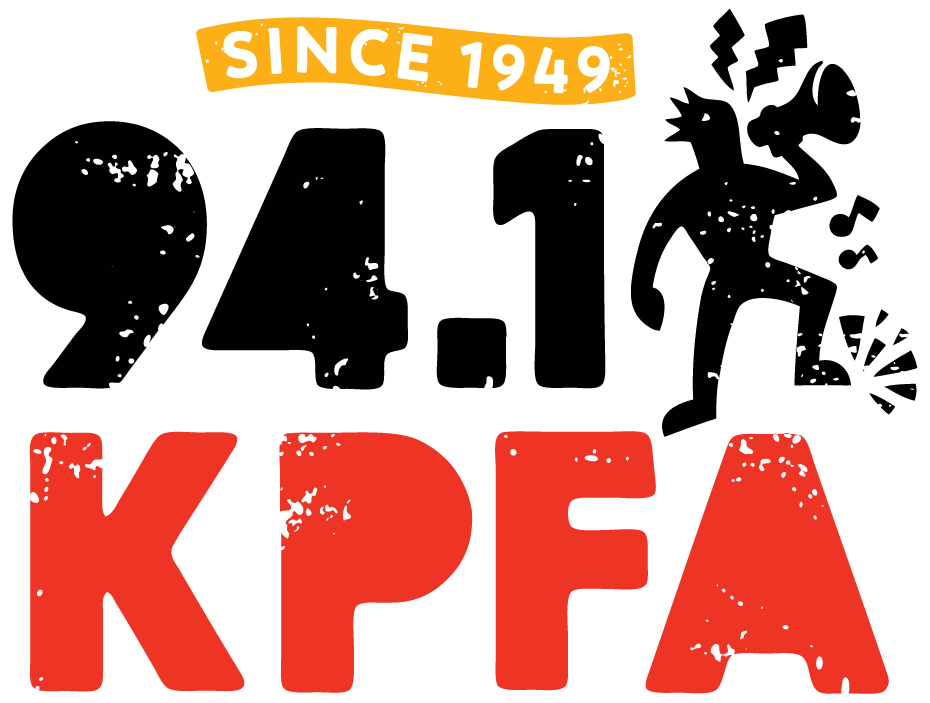
Photo: Pyramid Lake Paiute Reservation with Pyramid Lake in the back.
______
Around this time in normal years, Burning Man would be taking place in the Black Rock Desert in Nevada. Nearly 80,000 people attended the annual arts event in 2019, which started in the mid-80s and which has gone down in Burning Man lore. However, there’s a deeper history that many Burners may not know – one about the original inhabitants, who are still here. Our reporter Lucy Kang went to the Black Rock Desert to learn more.
(We wanted to add a quick note that this story was mostly recorded and produced before the COVID-19 pandemic, so a lot of things have changed. We’ll hear a quick follow up from our reporter at the end of the story.)
______
Black Rock City is built on the ancestral territory of the Northern Paiute People, the Numu. And their direct descendents are still here, grouped among different bands and tribes, like the Pyramid Lake Paiute Tribe. If you’ve ever driven to Burning Man from Reno, you’ve probably passed through their reservation, 50 miles south of here.
Burning Man gives several hundred free entry passes for tribe members to attend.
Cassandra Davis is from the Fallon Paiute-Shoshone tribe. She is married to Andrew Davis from the Pyramid Lake Paiute Tribe, who’s also known as Blackowl.
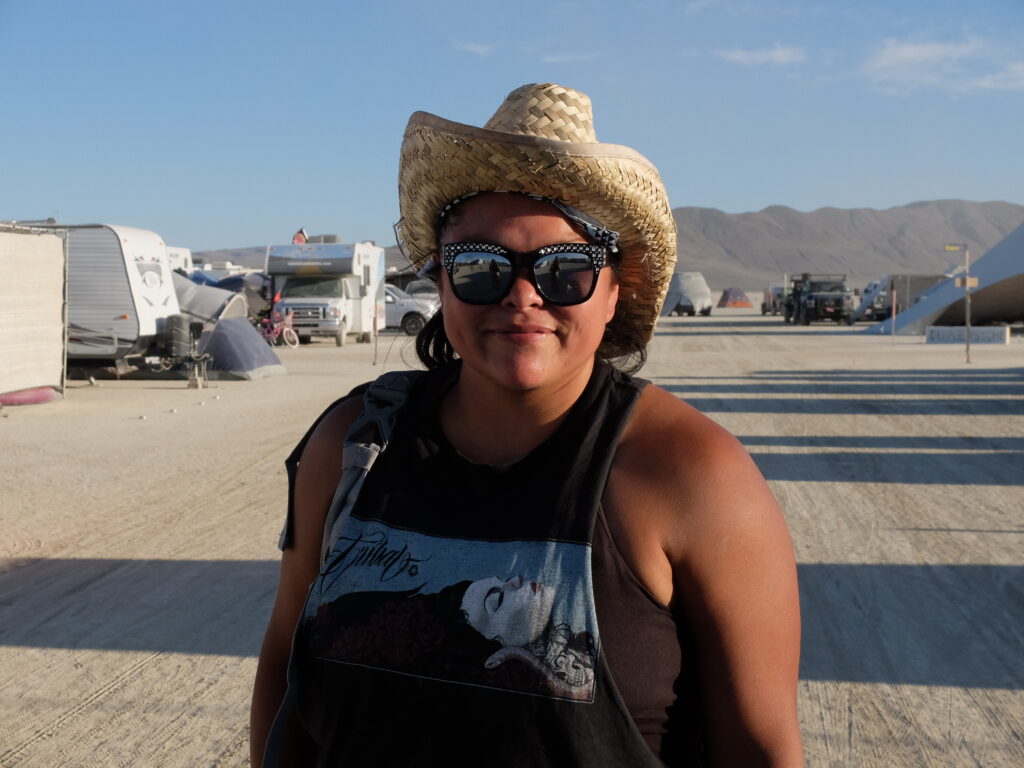
Photo: Cassandra Davis at Burning Man 2019.
I toss my bicycle into the back of their truck, and hop in. Cassandra is behind the wheel. Blackowl is riding shotgun.
“Alright, so we kind of tell people, you know, when we’re out here like yeah, we’re part of the tribe here, you know,” say Cassandra.
“I’ll tell people straight up man, I’m from Pyramid Lake Paiute Tribe, boy,” says Blackowl.
“And this actually used to be part of the Pyramid Lake,” continues Cassandra.
“This used to be the dry lake bed that was Pyramid Lake,” says Blackowl. “That’s why everybody drives through our lake, drive through our reservation. That’s why we get wristbands.”
Those are the free passes that the Burning Man organization gives to members of the Pyramid Lake Paiute Tribe as a sign of goodwill.
“This is all sacred land,” says Blackowl.
They drive slowly through the streets of Black Rock City, looking for a place to camp. Blackowl jumps out of the truck.
“He’s my wildcard,” says Cassandra, laughing.
He comes back after a few minutes with someone who’s offered them a place to set up their tent.
“I said, we’re Burners,” he explains. “We came here for the same reason. He asked me if I need a place to camp. Yes, I need a place to camp. And that’s how we do it. You don’t come in expecting to place somewhere. If you’re a real Burner, it always comes through.”
“What are you always saying, the playa provides?” asks Cassandra, laughing.
“The playa will provide, yup,” answers Blackowl.
Cassandra and Blackowl are locals. And when Burning Man comes to town, it’s a family affair.
Between me and my husband we have eight kids,” says Cassandra. “And our kids love Burning Man. They think it’s probably one of the funnest places on Earth.”
“They look forward to all the traffic and all the Burners coming through,” she continues. “They get excited seeing all the different art cars, you know. They’ll stop and take pictures. And they helped us with our bikes. They’ll put the lights on and help decorate our back-bags.”
Blackowl and Cassandra have been coming to this event for a long time.
Blackowl says it’s year 22 for him, though he doesn’t consider himself a Burner. Cassandra says, “I’m a Burner five years in.”
“I’m a local,” says Blackowl.
“And yeah, we’re locals,” says Cassandra. “But it’s more of a heart thing, you know, like you feel in your heart, you know, when you come out here just you know being home… We’re still local. We still have our jobs to go to. We still have to go to work every day and provide for our families, you know… I know a lot of people feel like this is their home.”
In fact, “Welcome Home” is how a lot of Burners greet each other.
“But you know at the end of the week, they go home,” she continues. “And we’re still here.”
Underneath Black Rock City is Black Rock Playa, an ancient lakebed that’s one of the largest and flattest places on earth. There are some areas here that are still sacred to the Northern Paiute people.
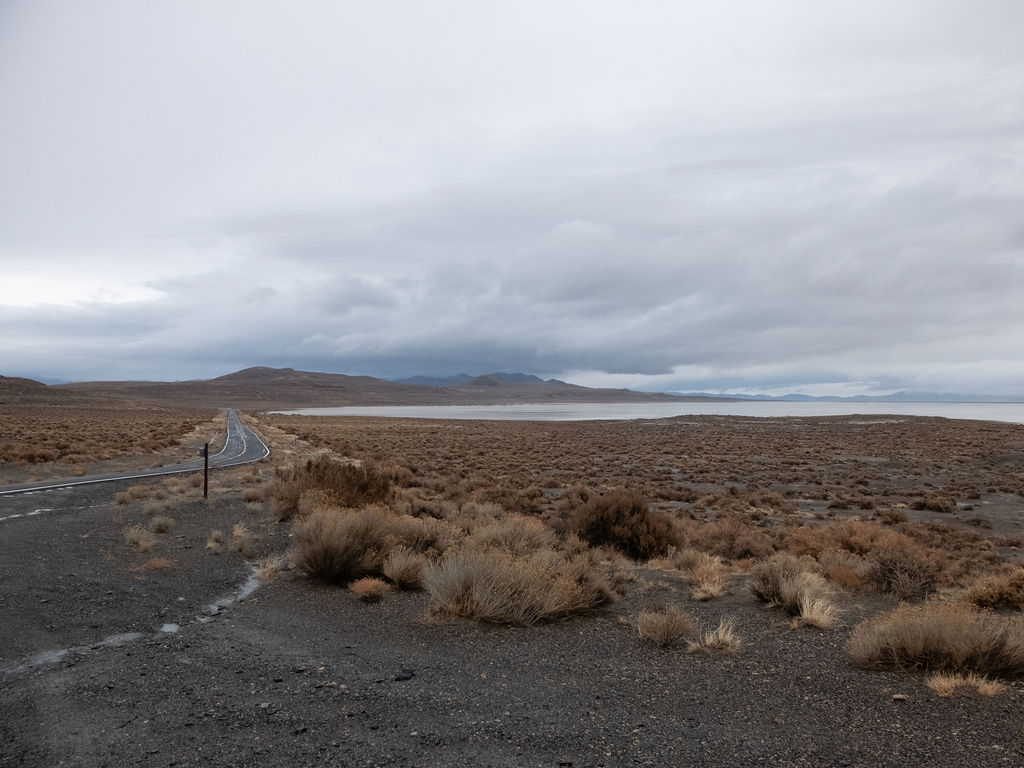
Photo: The Black Rock Playa in December 2019.
“You can see it on the Playa; you can see the sacred places that we still use,” says Dean Barlese.
Dean is a Pyramid Lake Paiute elder with a lot of spiritual and cultural knowledge. In fact, he’s on the tribe’s Cultural Committee. Right now, he’s sitting in a Burning Man camp, answering questions from camp members.
“People think we’re gone just because we’re on the reservation,” he says. “But we still come out here and make offerings in a lot of our sacred places that very few people know about. But we do – I do anyway.”
In fact, Dean says that his ancestors are buried in the mountains around Black Rock Playa.
Dean’s been going to Burning Man since 2001. He says he enjoys it. And he blesses the Burning Man Temple every year, at the request of the Temple volunteers. After the throngs of Burners have left, Dean comes back to bless the playa, to clear it of any negative energy Burners may have left behind.
“No matter what anybody says, no matter what the laws say, we’re still caretakers,” says Dean. “That has not been taken away from us by Creator.”
I wanted to learn more about what Dean means when he talks about the tribe’s relationship with the land.
So in December, months after Burning Man, I drive to the Pyramid Lake Paiute reservation. I take the route many Burners take, north on highway 447.
The landscape here is high desert, with shrubs everywhere – the type of place where tumbleweeds blow in the wind. This is the largest Native American reservation in Nevada. About a quarter of it is taken up by Pyramid Lake’s 200 square miles of blue water.
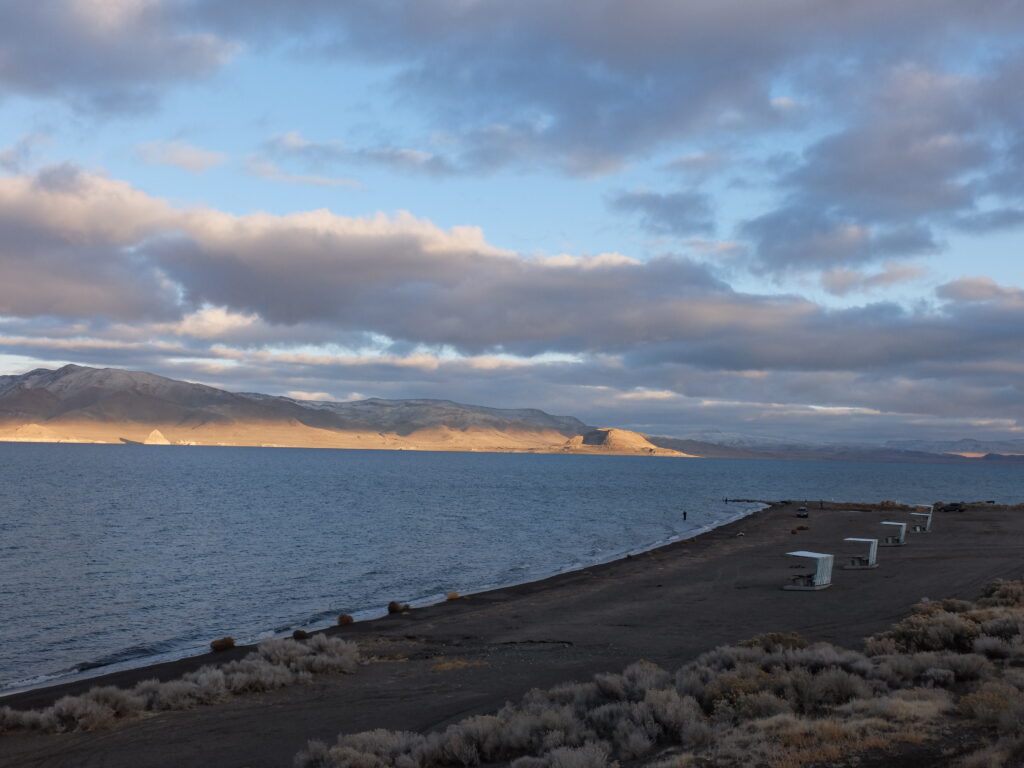
Photo: A view of Pyramid Lake with the pyramid-shaped rock in the distance.
From the road, there’s not much that marks the reservation except the occasional sign on the highway. I drive into Nixon, one of three towns on the reservation. I pass by what look like working ranches and single family homes. Some have rusting cars and trailers parked outside.
One of the most distinctive buildings in Nixon has a triangular roof. It’s meant to evoke the pyramid rock formation that Pyramid Lake is named for.
I’m here to talk to Billie Jean Guerrero. She knows a lot about the history of this place. She is the Museum Director for the Pyramid Lake Museum and Visitor Center, the only tribal museum in the state of Nevada.
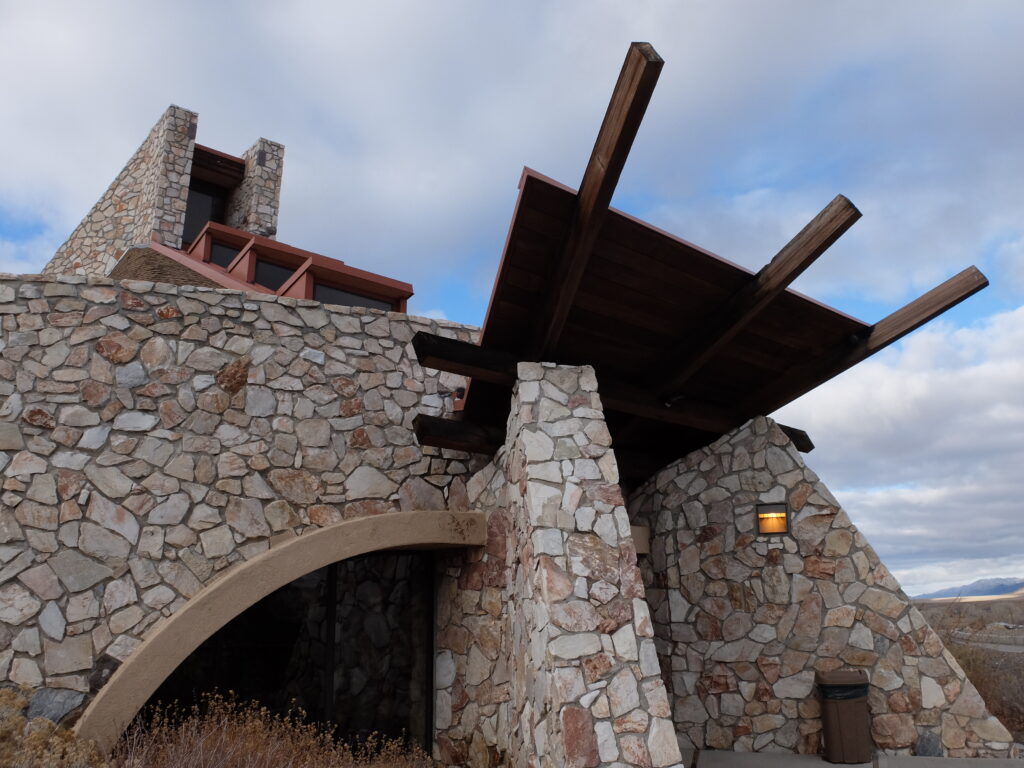
Photo: The Pyramid Lake Museum and Visitor Center
To really understand the tribe’s relationship with the Burning Man event, you need to understand a longer span of history.
“The Paiute people have been in this area for thousands and thousands of years,” says Billie Jean. “We have petroglyphs in our area that are known as the oldest in North America, and they are dated 14,800 years old.”
The original territory of the nomadic Northern Paiute people spanned Nevada, California, Oregon and Idaho. They lived here for generations and lived off the land. They gathered pinyon pine nuts and hunted antelope and deer. The band that would eventually be called the Pyramid Lake Paiute Tribe was known for eating the cui-ui fish, which was found only in Pyramid Lake. They roamed over the vast territory.
Everything changed for them in the mid-1800s.
The discovery of gold and silver in California and Nevada sent thousands of white settlers onto Paiute land. The mines built immense wealth for white settlers. But they decimated the traditional ways of life.
The settlers took water, grazing land and food sources – all scarce in the desert to begin with. Many Paiutes starved to death.
Armed conflict broke out. Wars were fought – and then mostly lost because the settlers were backed by the full force of the United States military.
Fighting also took place in the Black Rock Desert. Local historian Sessions Wheeler called these battles a war that “in respect to its ferocity, probably had no equal in Nevada history.”
By the end of the century, the Paiute people had been pushed off of 95% of their territory. Most of the land was taken by the federal government or white settlers and homesteaders. Some was carved into reservations, like the Pyramid Lake Paiute Reservation where I am now.
“It basically was a prison camp because people could no longer go off the reservation to hunt and gather as they survived in the past,” says Billie Jean.
And then the federal government developed a policy known informally as Kill the Indian, Spare the Man. They forced Native American communities to assimilate into white society.
“And one of the ways to assimilate was through boarding schools, which was to beat the Indian out of a person,” says Billie Jean.
Stewart Indian School was one such boarding school in Carson City, Nevada that children from nearby tribes were sent to.
“And basically children would be kidnapped from the reservations and taken to Stewart Indian school…, sometimes as early as five years old and parents not knowing where they were, says Billie Jean. “It was a very traumatic experience.”
Schools like this tried to completely wipe out Native cultures and languages.
“They had to forget about the Indian ways and adopt the white man’s ways,” she continues. “And if they didn’t follow that program, they would be beaten. Sometimes they would be killed.”
The US government didn’t end the policy of assimilation until 1934. Not long after, the Pyramid Lake Paiute Tribe gained federal recognition. Tribal elder Dean Barlese sums up this history.
“They tried to destroy us, annihilate us, waging wars of genocide against us. We’re still here,” he says.
Native communities are still dealing with the aftermath of policies enacted by our government.
“Those events caused trauma, which is long lasting,” says Billie Jean. “So it carries over from one generation to the next. And if there’s no healing that happens, then it just keeps on going.”
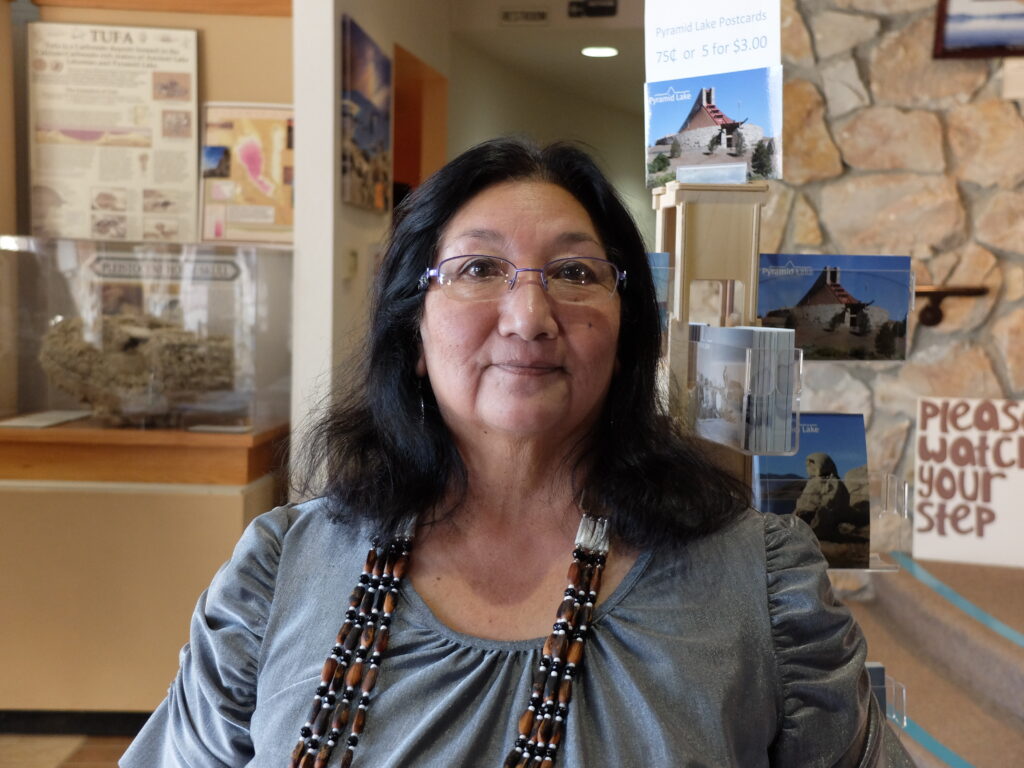
Photo: Billie Jean Guerrero, Director of the Pyramid Lake Museum and Visitor Center
Ultimately, the Pyramid Lake Paiute Tribe was never completely displaced from its ancestral homelands. But they lost most of the land their ancestors used to roam and forage, including places like the Black Rock Desert.
That land is now owned by the US government and overseen by the Bureau of Land Management.
It is also home to Burning Man.
“It’s really important to appreciate if you’re on Playa and you’re at Burning Man… to realize there’s a lot of people who have been there before you,” says the Burning Man Project’s Marnee Benson. “And we’re just the most recent visitors.”
Marnee works year-round to coordinate with the Pyramid Lake Paiute Tribe.
“We recognize that there’s a long history that includes… the tribal ancestors and more recently those Western settlers,” says Marnee. “And now our Burning Man community is included in that.”
“The Burning Man Project’s relationship goes back as far as 1990, when Burning Man first went to the Black Rock Desert,” she continues.
Those first Burners — about 90 in total — didn’t have a permit from the Bureau of Land Management. Rumors circulated among locals that hippie Satanists had flocked to the desert.
From a small group on the playa, Burning Man has grown to a city of tens of thousands. From a gathering on the fringes of society, it became first a corporation and now a non-profit with gross receipts of nearly $48 million in 2019. It’s impact on the tribe has grown too.
And that’s where Marnee comes in. Her official title is Director of Government Affairs for Burning Man. She deals with a whole alphabet soup of federal, state and local agencies, as well as the Pyramid Lake Paiute Tribe.
“People need to understand that, that we are a nation within a nation,” says Pyramid Lake Paiute Tribal Chairman Anthony Sampson.
“A lot of people don’t realize that the reservation is a sovereign nation with its own rules and laws,” says Water Quality Manager Kameron Morgan, who is not a tribe member but is employed by them.
To be clear, Chairman Sampson and Kameron are the only two people in this story authorized to speak officially on behalf of the Tribe.
A former tribal business officer explained in Reno News and Review that “For many years the Tribe worked off a handshake with the festival organizers who paid $10,000 for police, ranger, trash and emergency response services that the Tribe provided during the festival.”
By 2011, the former business officer realized that Burning Man only partially repaid the tribe what the extra services cost. Burning Man and the tribe signed an agreement for the first time the following year. These days, the tribe meets with the Burning Man Project every year to discuss the contract.
“I think it’s 50-50,” says Chairman Sampson. “We throw out what we were looking at and what our needs are, and they’ll come back with… what they can… help the tribe with. I think it’s somewhat off balance. But I believe that, you know, as this year we sat down with, with Burning Man, they were more open.”
“When you say off balance, do you mean in favor of Burning Man, slightly?” I ask.
“That would be, yeah, I guess so. Yeah,” he answers.
Fifteen hundred people live on the reservation. 80,000 go to Burning Man. And the median household income of Burners was over $100,000 in 2018 — more than two and a half times the median household income on the reservation. So, it’s not surprising that Burning Man has a lot of negotiating power, and impact.
Locals like Blackowl can have deep ties to Burning Man. But they see what most other Burners don’t – the costs that are externalized onto their communities – and onto people who are often just trying to go on with their daily lives.
“The festival itself is amazing,” says Andrew Davis Blackowl. “People bring problems.”
Cassandra Davis brings up two common concerns.
“The impact it has on the environment is number one, you know the trash,” she says. “People are courteous enough to clean up the playa because that’s the rules. But on the way out and on the way in, it’s more of an issue negatively because of all the trash that, you know, falls off the trailers, people leave behind when they pull over on the sides of the roads.”
Burning Man cleanup crews do come after the event to pick up trash on the state roads on the reservation – though trash can sometimes blow away before they get to it.
The second problem – is traffic. Like almost every local I talk to, Cassandra has a horror story about reckless drivers.
“One year we came out, and there was a lot of people coming, coming back in,” she says. “And they were crossing in front of us trying to pass an RV. There was a semi behind me, and he was hauling a**. I had to slam on my brakes. But I had to do it so much to where the truck behind me wouldn’t hit me and almost ran us off the road.”
In fact, last year a Nevada man died in a head-on collision with an RV on the highway that brings people to the playa.
Burning Man and its community does try to give back in various ways. There are volunteer work days on the reservation, and a donation of solar panels a few years back. And then there’s the cash.
“We have as an organization, made donations to the tribe for many, many, many years,” says Marnee. “So [the] senior center, the fire rescue, EMS department, and the museum. It’s several thousand dollars.”
Burners also bump up the local economy while they’re here.
“You Burners out there, stop by our convenience stores and the vendors out there,” he says. It helps boost the economy for our tribal membership and even our tax revenue on the reservation.” (A quick note here: the reservation and Pyramid Lake are currently closed to the general public due to COVID-19 concerns.)
Some families on the reservation rely on roadside vending to make ends meet. Every year at Burning Man, the highway to Black Rock Desert is dotted with food trucks, trash hauling services, and stands hawking blinky lights. Bunny’s Tacos was one of the earliest Indian taco stands. If you don’t know what an Indian taco is, here’s Bunny:
“Bunny’s taco stand started with a taco bread made from grandma’s kitchen, beans, lettuce, tomato, cheese, salsa made, homemade from Bunny’s little kitchen,” she says. “All homemade.”

Photo: Bunny’s Tacos, during the off-season.
Bunny’s Tacos is run out of a trailer that sits next to Maureen Pancho’s house in Nixon. Bunny is Maureen’s grandmother, but Maureen calls her Mom. The family has been selling Indian tacos during Burning Man for two decades. Maureen started helping out when she was just a kid.
“About 10 years ago Burning Man was just nonstop traffic,” says Maureen. “Everybody wanted a stand. Everybody. It’s everybody’s extra income during that time. So everybody’s popping up stands, whether it’s food, crafts, anything… Everyone counts on Burning Man because it’s an extra income to help everybody out here because there’s barely any jobs for those that don’t have one, and that’s how they can make their money.”
Historically, unemployment here was more than double the state average. And Maureen says the Burning Man business just hasn’t been as good for a couple of years.
Some think the drop in traffic might be due to the rise in alternative transportation like the Burner Express bus or private flights. Yes – Black Rock City has an airport. Whatever the reason for the slowdown, Maureen is feeling the effects.
“Back in the day, I was looking at least five to six grand,” says Maureen. “Now, honestly, I’m at, we’ll say, about a minimum wage of a week’s work… You’re barely making anything now… We count on Burning Man every year.”

Photo: Closeup of Bunny’s Tacos trailer.
Aside from the organization, there’s one group of Burners currently addressing the poverty here– the queer camp Comfort & Joy. They run a food drive every year. People leaving Black Rock City can drop off extra food at Bunny’s Tacos. Then Maureen helps distribute it to the many, many households that rely on food bank services.
“We have gotten over, I want to say roughly eight truckloads of food,” she says. “We fed over 150 families. And it varied from cans to fresh vegetables to eggs… Everything was gone within three days.”
Comfort & Joy Camp also holds a separate fundraiser. It raised around $14,000 last year for the tribal food bank. Fabien Gestas, known on the playa as Biscuits, runs both the fundraiser and the food drive. He says he wants to see more awareness from Burners.
“You’re not just driving through on State Route Nevada 447 heading to Black Rock City,” says Fabien. “You’re going through the land that has belonged to somebody for way longer than the United States has ever been here. And that there’s a sacredness to it.”
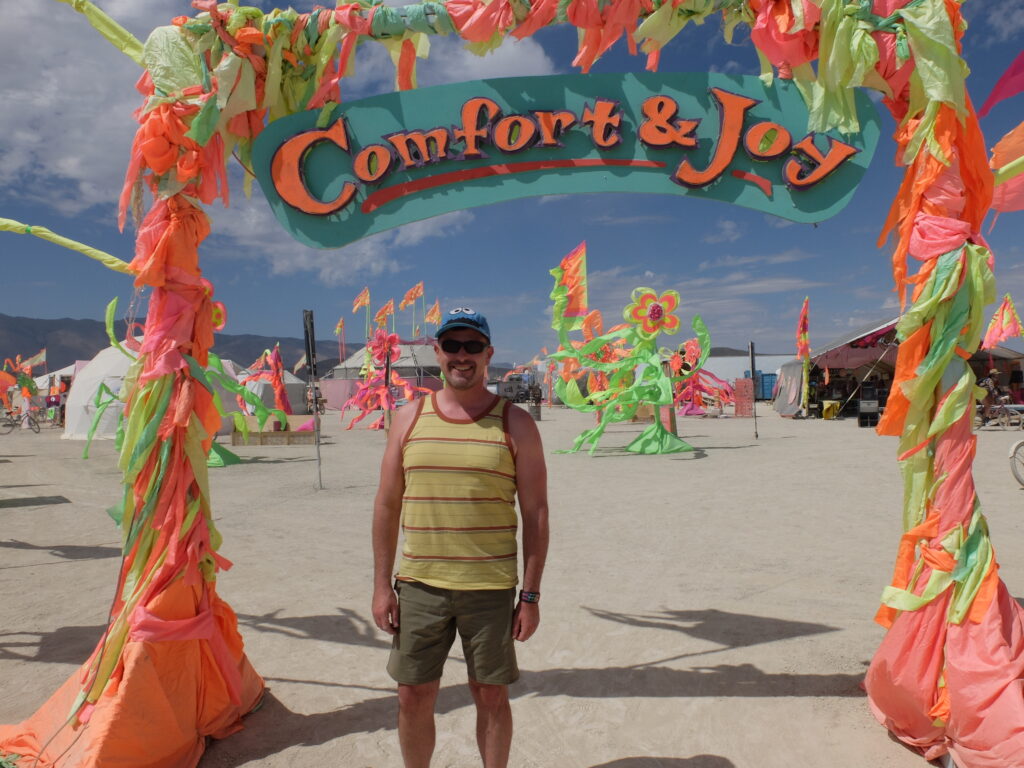
Photo: Fabien Gestas, aka Biscuits, at Comfort & Joy, Burning Man 2019.
I ask Fabien if he thinks Burners have a moral responsibility to redistribute some of their wealth and resource privilege.
“Just as human beings we have a moral responsibility to help one another,” he says. “But obviously that’s even compounded when we’re coming here to have this crazy celebration on their sacred land… And we do have a moral responsibility. Absolutely.”
Many Burners talk about the Black Rock playa as a blank slate. They build their city, like new, every year. But every year, they build it on land taken from the Northern Paiute people, who are still here.
This story was recorded primarily in 2019 and produced before the COVID-19 pandemic. A lot has changed since then. Andrew Davis Blackowl, the Pyramid Lake Paiute Tribe member who let me tag along and jump into the back of his truck, died earlier this year. In April, Burning Man was cancelled. For Paiute vendors like Bunny, the money is gone. And the tribe itself is struggling with COVID-19.
Chairman Anthony Sampson had the following to say from a video update on May 5, 2020. COVID-19 cases had just jumped into the double digits. Now the reservation and Pyramid Lake are closed to the general public.
“I’m pleading with you people out there, This is not a laughing matter. This is not a drill. This is the reality of what’s going on in our communities. This is reality, and it’s going to hurt people.”
On Paiute land, I’m Lucy Kang, for KPFA.
______
This story is a co-production of KPFA and KALW and is part of the Intersection podcast. It was edited by David Boyer and engineered by Gabe Grabin. Additional reporting from Jonathan Davis.
Special thanks to the Pyramid Lake Paiute Tribe Museum and Visitors Center. Comfort & Joy’s fundraising campaign for the Tribal Food Bank can be found on Facebook. Thanks also to Anjali L. Nath Upadhyay from Liberation Spring.
“Kaiva waito saugaymian” and “Weather Song” from the album Circle Dance Songs of the Paiute and Shoshone (CR-6283) by Judy Trejo. Courtesy Canyon Records, License 2019-092. All rights reserved.
“Sweet Betsy From Pike” as performed by Zelmer Ward and Vester Whitworth at Arvin FSA Camp, August 1, 1940. Charles L. Todd and Robert Sonkin Migrant Workers Collection, America Folklore Collection. Library of Congress. http://hdl.loc.gov/loc.afc/afcts.4099a2.
Additional music by Blue Dot Sessions (CC BY-NC 4.0 license).

